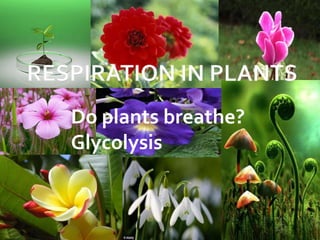
Respiration in plants (Do plants breathe and Glycolysis)
- 2. * Yes, plants require oxygen for respiration and they also give out carbon dioxide. * Plants unlike animals does not have any specialized organs for gaseous exchange but they have stomata and lenticels for this purpose.
- 4. Each plant part takes care of its own gas- exchange needs. Roots, stems and leaves respire at rates far lower than animals do. And also when cell photosynthesize, availability of oxygen is not a problem as oxygen is released within the cell itself.
- 5. Aerobic respiration : During respiration oxygen is utilized and carbon dioxide, water and energy are released as products. Anaerobic respiration : Glucose (Broken down to) →Energy (ATP) + Ethanol + Carbon dioxide .
- 6. Glycolysis ( breakdown of glucose ). Krebs cycle ( or citric acid cycle ). ETC ( Electron transport chain ).
- 7. Glycolysis starts off with glucose { }. C-C-C-C-C-C There are two important phases of Glycolysis as follows : 1) INVESTMENT PHASE 2) PAYOFF PHASE
- 8. This phase uses 2 ATP’s. Since 2 ATP’s are used we call it as investment phase. [Business term] Then there is a breakdown of glucose into 2.3 carbon compounds. C-C-C-C-C-C C-C-C C-C-C ( They actually have a phosphate group on them that comes from ATP’s. P-C-C-C C-C-C-P ( This is often referred to as PGAL [ phospho glycer aldehyde]
- 9. Now each of these 2 PGAL molecules enter the payoff phase. In the payoff phase each of these PGAL’s turn into pyruvates (or pyruvic acid ). P-C-C-C C-C-C-P C-C-C (pyruvate) C-C-C (pyruvate) ( 3 carbon compound )
- 10. P-C-C-C C-C-C-P 2 ATP’s 2ATP’s NADH+ NADH+ C-C-C (pyruvate) C-C-C (pyruvate) ( 3 carbon compound ) Production of 2 ATP’s and NADH+ takes place. NADH is a compound formed by NAD+ + H2 It is produced by raw material NAD+ and then reduced by adding hydrogen. Hence NAD+ gets reduced to NADH.
- 11. 2 ATP’s 2 NADH’s 2 Pyruvates End or key product of glycolysis is pyruvate.
- 14. This depends on the cellular needs. There are 3 major ways in which different cells handle pyruvic acid produced by glycolysis that are : Lactic acid fermentation. (It is a biological process by which glucose, fructose, and sucrose, are converted into cellular energy and the metabolite lactate.) Alcoholic fermentation. (It is a biological process in which sugars such as glucose, fructose, and sucrose are converted into cellular energy and thereby produce ethanol and carbon dioxide as metabolic waste products.) Aerobic respiration. (It is a chemical reaction is which oxygen is used to break glucose down into carbon dioxide and water. Energy is also released in this process.)
- 15. http://www.youtube.com/watch?v=FOaXTjR hV2E http://biology.about.com/od/cellularprocesse s/a/aa082704a.htm http://www.youtube.com/watch?v=O5eMW4 b29rg
- 16. PPT by Harmanpreet Kaur.
